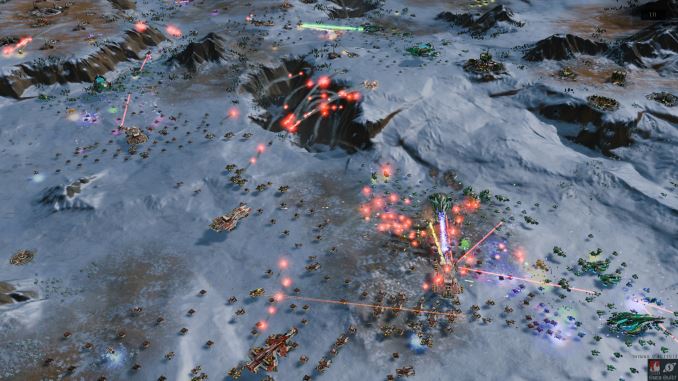Ashes of the Singularity Revisited: A Beta Look at DirectX 12 & Asynchronous Shading
by Daniel Williams & Ryan Smith on February 24, 2016 1:00 PM ESTClosing Thoughts
Wrapping up our second look at Ashes of the Singularity and third overall look at Oxide’s Nitrous engines, it’s interesting to see where things have changed and where they have stayed the same.
Thanks to the general performance optimizations made since our initial look at Ashes, the situation for multi-GPU via DirectX 12 explicit multi-adapter is both very different and very similar. On an absolute basis it’s now a lot harder to max out a multi-GPU configuration; with reasonable quality settings we’re CPU limited even up to 4K, requiring we further increase the rendering quality. This more than anything else handily illustrates just how much performance has improved since the last beta. On the other hand it’s still the most unusual pairing – a Radeon R9 Fury X with a GeForce GTX 980 Ti – that delivers the best multi-GPU performance, which just goes to show what RTG and NVIDIA can accomplish working together.
As for the single GPU configurations, I’m not sure things as they currently stand could be any more different. NVIDIA cards have very good baseline DX11 performance in Ashes of the Singularity, but they mostly gain nothing from Ashes’ DX12 rendering path. RTG cards on the other hand have poorer DX11 performance, but they gain a significant amount of performance from the DX12 rendering path. In fact they gain so much performance that against traditional competitive lineups (e.g. Fury X vs. 980 Ti), the RTG cards are well in the lead, which isn’t usually the case elsewhere.
Going hand-in-hand with DX12, RTG’s cards are the only products to consistently benefit from Ashes’ improved asynchronous shading implementation. Whereas our NVIDIA cards see a very slight regression (with NVIDIA telling us that async shading is not currently enabled in their drivers), the Radeons improve in performance, especially the top-tier Fury X. This by itself isn’t wholly surprising given some of our theories about Fury X’s strengths and weaknesses, but for Ashes of the Singularity performance it further compounds on the other DX12 performance gains for RTG.
Ultimately Ashes gives us a very interesting look at the state of DirectX 12 performance for both RTG and NVIDIA cards, though no more and no less. As we stated at the start of this article this is beta software and performance is subject to change – not to mention the overall sample size of one game – but it is a start. For RTG this certainly lends support to their promotion of and expectations for DirectX 12, and it should be interesting to see how things shape up in March and beyond once the gold version of Ashes is released, and past that even more DirectX 12 games.











153 Comments
View All Comments
TheJian - Sunday, March 6, 2016 - link
The highlight here isn't dx12, but rather how badly AMD is doing DX11, which is what most games will run on for quite some time to come (only 10% run win10, and much of that base doesn't have a card that can run this game at even 1080P at 30fps). A decent sized group of win10 users go back to win7 also...LOL. I'm more interested in Vulkan, now that it's out, I think it will take over dx12 after a year as it runs everywhere but consoles and they are a totally different animal anyway.This just goes to show what happens when you can't afford to support your products. IE, AMD constantly losing money quarter after quarter while R&D drops too. NV on the other hand, has the cash to massively improve dx11 (which is 90% of the market, more if you consider not everyone running win10 is even a gamer), while also making a dx12 driver. AMD clearly needs to devote more money to their current card users (dx11), but can't afford to. AMD is spending their money on the wrong things time and time again. You can blame consoles for this last 5yrs of losses, as that money should have went into making ZEN 4yrs ago, much faster DX11 support, mobile chips should be on rev 5-6 etc like NV and everyone else etc etc. We would not be looking at NV owning 82%+ of the gpu market right now, and Intel would have had a major competition problem for the last 4-5 yrs instead of basically being able to pour all their resources into mobile while beating AMD to death on cpu.
EugenM - Tuesday, June 7, 2016 - link
I cannot speak of AMD CPUs, but AMD gpus are doing very well on DX11 games, its not the DX11 implementation of AMD that is at fault for performance issues, rather than Nvidia sabotaging time and time again their games, every game which is labeled Nvidia has a potential to sabotage the entire AMD lineup and AMD has little to nothing to do about it, this is not a tin foil conspirancy theory, its a fact proven game after game after game and easelly found on google, try searching for batman games and other epic unreal engine games, try searching for crysis 2 and nvidia gameworks games, youll see what i mean. If youre a small company you cannot really do much about a big monopoly like Nvidia and Intel youre 1 fighting vs 2. Dirty tactics against AMD and even illegal tactics have also been applied by Intel vs AMD, thats why Intel was fined with a huge ammount of money but in the end the damage to AMD was already done and it was too late for AMD to recover properly. You need to realise not everything is so simple.jacksonjacksona - Thursday, March 17, 2016 - link
( www).(ajkobeshoes).(com )christian louboutin
jordan shoes $60-
handbag
AF tank woman
puma slipper woman
=====
( www).(ajkobeshoes).(com )
hhhhhhhh
hhhhhhhh